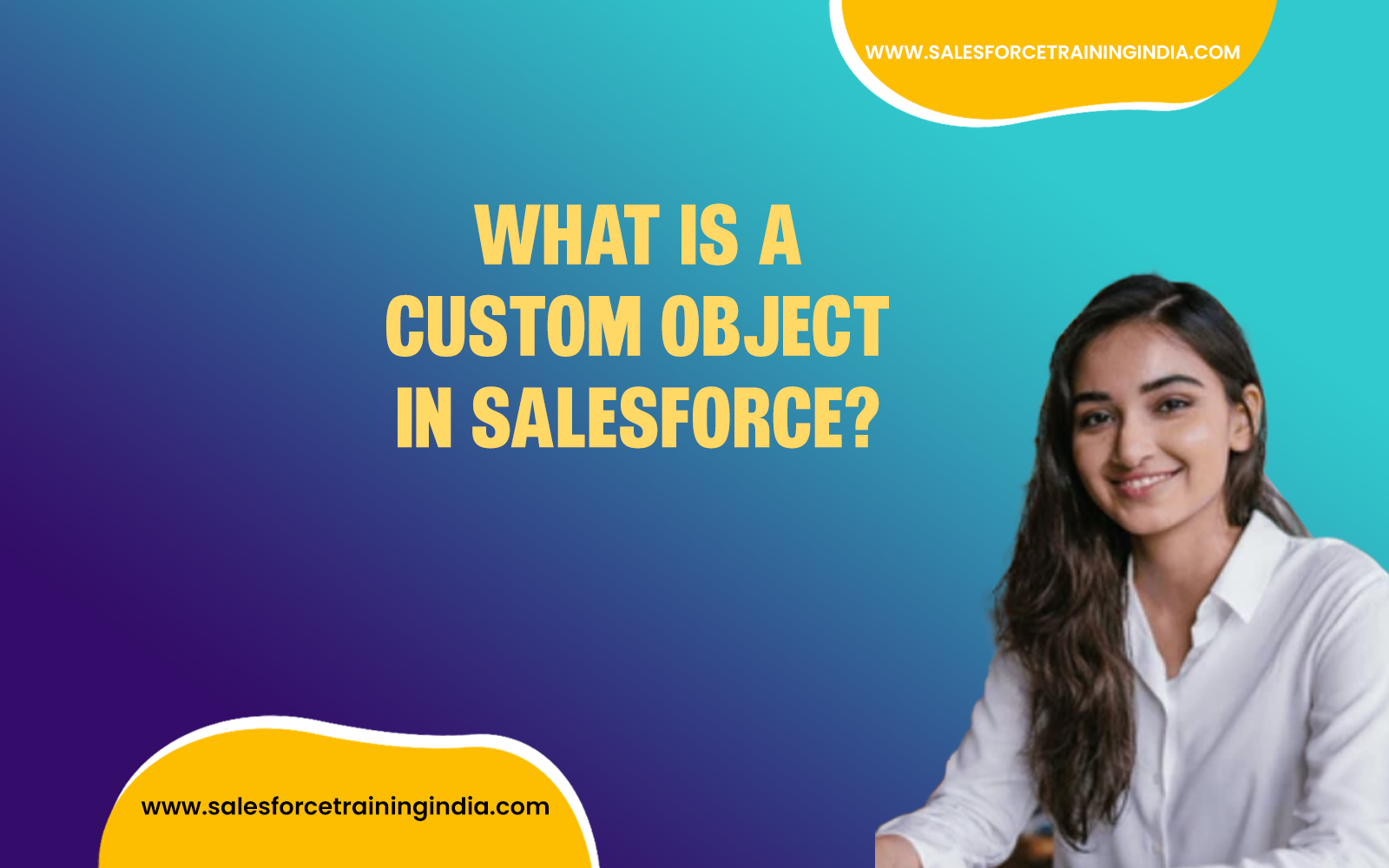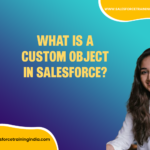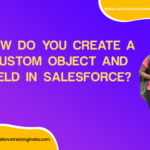Custom Object in Salesforce
In Salesforce, a custom object is a user-defined database table that allows you to store information unique to your organization’s requirements. Custom objects extend the functionality of Salesforce by allowing you to create specific data structures that aren’t provided by default in the standard Salesforce schema. They are similar to standard objects like Accounts or Contacts but are tailored to fit the unique business processes and data management needs of an organization.
How to Create a Custom Object in Salesforce?
Creating a custom object in Salesforce is a straightforward process that allows you to define new data structures tailored to your specific business needs. Custom objects are used to store information that is unique to your organization, complementing the standard objects provided by Salesforce. Follow these steps to create a custom object:
Step 1: Log in to Salesforce
Log in to your Salesforce account. Ensure you have the necessary permissions (usually System Administrator) to create custom objects.
Step 2: Navigate to the Object Manager
- Click on the Setup icon (the gear icon) in the upper right corner of the Salesforce interface.
- In the Quick Find box, type Object Manager and select it from the results.
Step 3: Create a New Custom Object
- In the Object Manager, click on the Create dropdown button.
- Select Custom Object from the options.
Step 4: Define the Custom Object
- Label: Enter a label for the custom object (e.g., “Project”).
- Plural Label: Enter the plural form of the label (e.g., “Projects”).
- Object Name: Salesforce automatically generates an API name based on the label, but you can customize it if needed.
- Description: Provide a brief description of the custom object.
- Context-Sensitive Help Setting: Choose the type of help setting you want to apply.
- Record Name: Choose the data type for the record name (Text or Auto Number). If you select Auto Number, define the display format and starting number.
Step 5: Set Optional Features
- Allow Reports: Check this box if you want to enable reporting on the custom object.
- Allow Activities: Check this box if you want to allow activities (tasks and events) to be associated with the custom object.
- Track Field History: Check this box if you want to track changes to the custom object’s fields.
- Launch New Custom Tab Wizard after saving this custom object: Check this box if you want to create a custom tab for this object.
Step 6: Save the Custom Object
- Click Save to create the custom object.
Step 7: Create Custom Fields (Optional)
After saving the custom object, you can create custom fields to store specific data related to the object. Follow these steps:
- In the custom object’s detail page, go to the Fields & Relationships section.
- Click on New to create a new custom field.
- Choose the data type for the field (e.g., Text, Number, Date).
- Fill in the required details for the custom field and click Next.
- Set field-level security and click Next.
- Add the field to the page layout and click Save.
Step 8: Create a Custom Tab (Optional)
If you checked the option to launch the custom tab wizard:
- Follow the steps in the wizard to create a custom tab for your object.
- Choose a tab style, specify the tab visibility settings, and click Save.
Example of Creating a Custom Object and Field Using Apex
You can also create custom objects and fields programmatically using Apex:
// Create Custom Object
MetadataService.MetadataService metadataService = new MetadataService.MetadataService();
MetadataService.CustomObject customObject = new MetadataService.CustomObject();
customObject.fullName = 'Project__c';
customObject.label = 'Project';
customObject.pluralLabel = 'Projects';
customObject.nameField = new MetadataService.CustomField();
customObject.nameField.type_x = 'Text';
customObject.nameField.label = 'Project Name';
metadataService.createMetadata(new MetadataService.CustomObject[] { customObject });
// Create Custom Field
MetadataService.CustomField customField = new MetadataService.CustomField();
customField.fullName = 'Project__c.Description__c';
customField.label = 'Description';
customField.type_x = 'TextArea';
metadataService.createMetadata(new MetadataService.CustomField[] { customField });By following these steps, you can easily create custom objects in Salesforce, allowing you to tailor the platform to your specific business requirements.
Custom objects are integral to the Salesforce platform’s flexibility, enabling businesses to model and manage virtually any type of data specific to their operations. They allow for the customization of the Salesforce environment to reflect the company’s data architecture, enhancing the CRM’s ability to support diverse and complex business processes. With custom objects, Salesforce becomes not just a CRM tool but a comprehensive platform capable of managing a wide array of business needs.
Frequently Asked Questions (FAQs)
1. What is an example of a custom object in Salesforce?
An example of a custom object in Salesforce could be a “Project” object. This custom object might be used by a project management team to track details about various projects within an organization. The “Project” object can have custom fields such as Project Name, Start Date, End Date, Budget, and Status. By creating this custom object, users can store and manage project-specific data that is not available in standard Salesforce objects, providing a tailored solution that meets their unique business requirements.
2. What is the difference between a standard object and a custom object in Salesforce?
The difference between a standard object and a custom object in Salesforce lies in their origin and purpose. Standard objects are pre-built objects provided by Salesforce, such as Accounts, Contacts, Opportunities, and Leads. These objects come with predefined fields and functionality that cover common business needs. Custom objects, on the other hand, are created by users to meet specific business requirements that are not addressed by standard objects. Custom objects allow users to define their fields, relationships, and custom functionality, providing greater flexibility and customization options.
3. What is a custom object?
A custom object in Salesforce is a database table that users create to store information unique to their organization. Custom objects enable users to extend Salesforce’s capabilities by defining new data structures tailored to their specific business needs. For example, an organization might create custom objects to track information about properties, inventory, or events. Custom objects can have custom fields, relationships with other objects, and custom user interfaces, allowing for a highly personalized and efficient data management system within Salesforce.
4. What is the difference between big object and custom object in Salesforce?
The difference between big objects and custom objects in Salesforce primarily relates to their capacity and use cases. Custom objects are designed for storing data that can be managed within the limits of a standard Salesforce database, typically involving records that require transactions and immediate access. Big objects, however, are designed to handle massive volumes of data that are generally historical or archival in nature. Big objects can store billions of records and are optimized for performance with large data sets, but they do not support the same transactional operations and real-time interactions as custom objects.
5. Why do we need custom objects in Salesforce?
We need custom objects in Salesforce to cater to specific business needs that cannot be fulfilled by standard objects. Custom objects allow organizations to create data models that are unique to their operational requirements, enabling them to track and manage information specific to their industry or processes. By using custom objects, businesses can ensure that their Salesforce implementation is fully aligned with their workflows, resulting in more efficient data management, better reporting capabilities, and enhanced user productivity. Custom objects provide the flexibility needed to adapt Salesforce to a wide variety of use cases and industry-specific needs.
6. How to identify whether an object is standard or custom in Salesforce?
To identify whether an object is standard or custom in Salesforce, you can look at the object’s API name. Standard objects have simple API names, such as Account, Contact, or Opportunity. Custom objects, on the other hand, always end with the suffix “__c” (double underscore followed by the letter “c”). For example, a custom object named “Project” would have the API name Project__c. Additionally, when viewing objects in the Object Manager within the Salesforce Setup menu, custom objects are typically listed under a separate section labeled “Custom Objects,” making them easy to distinguish from standard objects.
7. What are the limitations of custom objects in Salesforce?
While custom objects in Salesforce provide significant flexibility, they come with certain limitations. One key limitation is the storage limits imposed by Salesforce, which can restrict the number of custom objects and fields you can create based on your edition. For example, the Developer Edition allows up to 200 custom objects. Another limitation is the API request limits, which can impact performance and integration capabilities if exceeded. Custom objects also have sharing model restrictions, as they may not support all the complex sharing rules that standard objects do. Additionally, some advanced features and functionalities available for standard objects might not be fully supported for custom objects.
8. How many types of objects are there in Salesforce?
There are several types of objects in Salesforce, categorized primarily into standard objects and custom objects. Standard objects are pre-built by Salesforce and include core entities like Accounts, Contacts, Leads, and Opportunities. Custom objects are created by users to capture information specific to their business needs. Beyond these, there are big objects designed to store massive volumes of data and external objects used for integrating data from external systems without storing it directly in Salesforce. Each type of object serves different purposes, allowing Salesforce to cater to a wide range of business requirements and data management needs.
9. Can a custom object be used in the standard application?
Yes, a custom object can be used in the standard application in Salesforce. Custom objects integrate seamlessly with standard Salesforce features, such as workflows, validation rules, reports, and dashboards. They can be added to page layouts, related lists, and custom tabs, making them accessible and usable within the standard Salesforce user interface. This integration allows users to interact with custom objects just like they do with standard objects, ensuring a cohesive and comprehensive data management experience across the Salesforce platform.
10. How do I convert a custom object to a standard object in Salesforce?
Converting a custom object to a standard object in Salesforce is not directly possible, as standard objects are predefined by Salesforce and cannot be modified or created by users. However, you can migrate data from a custom object to a standard object by exporting the data from the custom object and then importing it into the standard object using tools like the Data Loader or Data Import Wizard. This process involves mapping custom object fields to corresponding standard object fields and ensuring data integrity during the migration. While the conversion itself isn’t feasible, data migration allows you to leverage standard object capabilities for your existing custom object data.
11. Can we edit custom object in Salesforce?
Yes, you can edit custom objects in Salesforce to modify their structure and behavior according to your evolving business needs. Editing a custom object involves making changes to its fields, relationships, page layouts, and validation rules. You can add new fields, delete unnecessary ones, or change field properties such as data types and default values. Additionally, you can update the custom object’s relationships with other objects, customize its page layouts to improve user interface, and adjust validation rules to enforce new data integrity requirements. These modifications can be performed through the Object Manager in Salesforce Setup, providing flexibility to adapt your custom objects as your business processes change.
12. What is the difference between a field and a record in Salesforce?
In Salesforce, a field and a record are two fundamental components that serve different purposes. A field is a single piece of data within an object, defining a specific attribute of that object, such as a name, date, or number. Fields are the columns in a database table. For example, in an Account object, fields might include Account Name, Industry, and Annual Revenue. A record, on the other hand, is a single instance of an object, containing values for all the fields defined in that object. Records are the rows in a database table. For instance, a single account record would include specific values for Account Name, Industry, and Annual Revenue fields, representing one account in your database.
13. What is the difference between standard object and custom object in Salesforce?
The difference between standard objects and custom objects in Salesforce lies in their origin and purpose. Standard objects are pre-defined by Salesforce and cover common business entities such as Accounts, Contacts, Opportunities, and Leads. They come with built-in fields, relationships, and standard functionality that support typical CRM tasks. Custom objects, however, are created by users to capture information unique to their business processes. Custom objects allow for the creation of custom fields, relationships, and tailored functionality that are not available in standard objects, providing greater flexibility and customization to meet specific business needs.
14. What is the difference between a tab and an object in Salesforce?
In Salesforce, an object and a tab serve different roles in the data management and user interface. An object is a database table that stores specific types of information, such as Accounts, Contacts, or custom entities like Projects. Objects define the structure of data and contain fields and records. A tab, on the other hand, is a user interface element that provides access to an object’s data. Tabs are displayed in the Salesforce app’s navigation bar and allow users to view, create, and manage records for a particular object. While an object defines how data is stored, a tab provides the means to interact with that data within the Salesforce interface.
15. What is the difference between an object and a field?
The difference between an object and a field in Salesforce is fundamental to understanding its data structure. An object is a database table that stores a specific type of information, such as Accounts, Contacts, or custom objects like Projects. It defines the overall structure and schema of that type of data, including fields, relationships, and metadata. A field is an individual piece of data within an object, representing a specific attribute or property of the object. Fields are the columns in the database table, and they define the type of data that can be stored (e.g., text, number, date). For example, the Contact object might have fields like First Name, Last Name, Email, and Phone Number, each capturing specific details about a contact.
Are you eager to excel in Salesforce? Look no further than our specialized Salesforce training in Hyderabad. We offer a comprehensive, project-based course that immerses you in real-time scenarios and equips you with practical skills and up-to-date knowledge. With a strong focus on daily notes, hands-on projects, and meticulous preparation for certification exams and interviews, our training ensures you’re fully prepared for the diverse challenges of the Salesforce industry.
Don’t delay in advancing your career. Enroll today in our Salesforce online course and benefit from personalized mentorship from seasoned instructors. Whether you’re starting from scratch or looking to deepen your expertise, our tailored program in Hyderabad is designed to empower your success. Take the initiative to elevate your professional journey with us.





